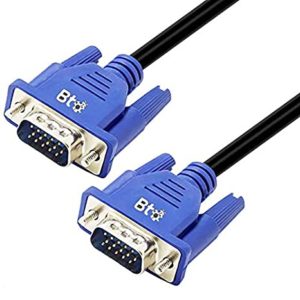
Despite the need for a separate audio cable, VGA and DVI connectors remain essential for transmitting signals from older video devices. If you’re a new owner of a home theater system, the difference between these high-quality cables can get quite confusing. Fortunately, our experts decided to compare the two to see which will deliver better signal quality.
VGA or DVI?

- RGB analog video signal
- Maximum Resolution: 2053x1536
- Good picture quality
- DVI and HDMI converters

- Hot-pluggable
- Faster and accurate display
- Multiple types of DVI ports
- Compatibility: HDMI & VGA
Defining VGA and DVI
Before we delve deeper into the comparison, let us first define what DVI and VGA connectors mean. For starters, you should know that VGA stands for Video Graphics Array, while DVI stands for Digital Visual Interface.
Although a VGA port is an older technology than a DVI connector, both cables are known to transmit video signals from a source device. However, unlike VGA cables that only carry an analog signal, DVI cables work well with digital and analog equipment.
If you haven’t encountered these cables yet, our team suggests inspecting the colors of your available connectors. VGA cables are the ones in blue, and DVI connectors often have white ports.
Features of VGA and DVI
Signals
The key difference between VGA connectors and DVI cables is the video signal transmitted to the display device. From a user’s perspective, they have similar construction with female ports and male endpoints. However, a VGA connector only delivers an analog signal.

The digital video signal received through a VGA cable must undergo analog conversion before the actual transmission. Our testers highly suggest this cable for a display device like a CRT monitor or Cathode Ray Tube, as it’s known to accept analog signals.
Most display devices operate with a digital interface, so it’s not surprising that many supports DVI port more than its alternative. These cables are digital-only as well; that’s why signal conversion isn’t needed.
Image Quality
The picture quality battle between DVI vs. VGA undoubtedly belongs to DVI cables. You may not know it, but the video signals transmitted from analog-to-digital lead to signal degradation.

During the test, our team noticed that the video quality from a VGA connector cable is more susceptible to noise than its DVI cable alternative.
Since these cables don’t undergo conversion, the transmission is quicker and smoother. Although the difference isn’t massive in Standard Definition, playing HD videos and displays showed its superiority.
Winner: DVI
Audio
Unfortunately, both DVI vs VGA cables can’t transmit audio signals. You’ll be needing a separate audio cable to accommodate its connection.

If you’re aiming for audio signal integration, our audiovisual team suggests getting LCD monitors that support HDMI cable connections. On top of that, you’ll only need a single cable to receive both audio and video signals [1].
Compatibility With Devices
As a newer technology, the number of devices that support DVI connection is undeniably greater than VGA. And while its alternative allows signal conversion for increased compatibility, it goes at the expense of lower image quality.

Our testers noticed that VGA only comes with one type of RGB connector while its alternative has three. It has the pure DVI-D output that supports single and dual-link formats, the DVI-A cable that works with analog, and DVI-I that accommodates digital and analog signals.
Winner: DVI
Transfer Speed
As previously stated, DVI connection is faster and smoother than VGA because it doesn’t require conversion from analog to digital signals.
Winner: DVI
Cable Size and Length
The quality of analog and digital signals are affected by cable size and length. Typically, longer cables tend to be more susceptible to disruption, which VGA often suffers from. In contrast, DVI cables can use boosters to avoid this.
FAQ
Are VGA and DVI still used?
Yes, VGA and DVI are still used. Given that the majority of TV users still buy 1080p displays, the latter has a strong presence in the market. On the other hand, VGA connectors may be less popular now, but it’s still used for analog transmission on older video devices.
Overall Winner: DVI
After carefully evaluating VGA vs. DVI features, our resident testers concluded that DVI connectors are far better options than its alternative. When you transfer video waves from a device that supports it, our tests proved that it delivers better image quality and faster transmission suitable for an enhanced viewing experience.
The post VGA vs DVI (2021) — Learn the Important Differences appeared first on The Product Analyst.
from The Product Analyst https://theproductanalyst.com/vga-vs-dvi/
No comments:
Post a Comment